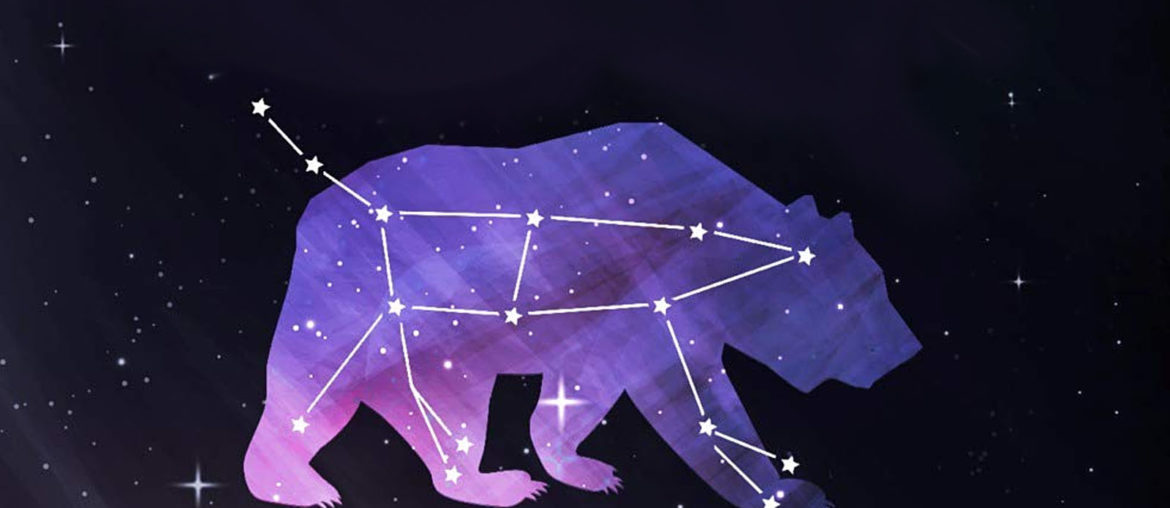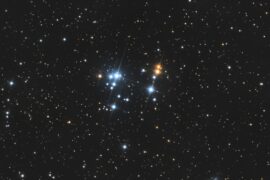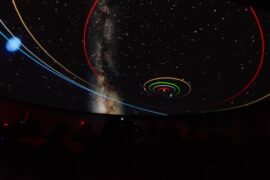It is always fun to look up at the sky and find shapes in the stars. It is human nature to try to find things in the unknown that we can relate to. This is why the ancients spent a lot of time finding shapes of animals and heroes and called them constellations.
A constellation is simply a group of stars in the sky that when you use your imagination form a certain shape.
Ursa Major is one of the most famous constellations in the sky. Ancient people thought it was shaped like a bear and that’s exactly where its name comes from as it means The Big Bear in ancient Greek.
In astronomy, Ursa Major is also referred to as Ursae Majoris and the stars that form it are named with that label. The stars on a constellation are regularly named using that constellation’s name, prefixed by a letter from the Greek alphabet. So the stars in Ursa Major are called Alpha Ursae Majoris, Beta Ursae Majoris, etc.
Some stars also have “proper names”, which are shorter, common names and generally easier to remember. For example, Alpha Ursae Majoris is also referred to as Dubhe which comes from the Arabic word for ‘bear’.
Ursa Major is famous for three things:
First, because it is visible for most of the year and from almost the whole world.
Second, Ursa Major was used a lot as a navigational tool by sailors and travelers who used it to find North before compasses were invented.
And finally, because it contains The Big Dipper. A group of stars that are shaped like a cooking pot. Let’s learn some more about that.

Why is Ursa Major also called ‘The Big Dipper’?
Let’s start by making something clear. The Big Dipper is not a constellation, it is an asterism. An asterism is a small group of stars that form a recognizable pattern in the sky and that are easy to point to. Asterisms don’t officially form a constellation, but they are usually part of other constellations. Other famous asterisms include the Northern Cross, which is part of the Cygnus constellation and Orion’s Belt.
The Big Dipper is simply a fun pattern in the sky that is easy to find, but it is only part of the Ursa Major constellation which is shaped like a bear. This is where the confusion comes from as many people mistakenly refer to the Big Dipper as a constellation or they call it Ursa Major forgetting about the other 13 big stars or so that form it.
Fact Sheet
| Astronomical Abbreviation | UMa |
| Symbolism | The Great Bear |
| Brightest star | Alioth (Epsilon Ursae Majoris) |
| Number of stars | 20 Major, 135 Total |
| Stars with planets | 21 |
| Visible in America from | Brasil to Greenland |
| Visible in Asia/Oceania from | Central Australia and above |
| Visible in Europe from | Everywhere |
| Visible in Africa from | Everywhere except parts of South Africa |
| Area | 1280 sq. deg. (3rd) |
| Right Ascension | 10.67h |
| Declination | +55.38° |
| Quadrant | NQ2 |
| Bordering constellations | Draco Camelopardalis Lynx Leo Minor Leo Coma Berenices Canes Venatici Boötes |
Fun Facts About Ursa Major
The Big Dipper name
The “Big Dipper” nickname for the constellation comes from native-American mythology where they also saw it as a bear but believed the three trailing stars of Ursa Majoris were three hunters with one of them carrying a cooking pot to cook him in case they got lucky.
Ursa Major can be used as a clock
In the Northern hemisphere (everywhere North of Colombia), the constellation can be seen all year round. It also does something very useful and curious. It circles around the northern star (Polaris) counter-clockwise and it takes almost exactly 24 hours to make a lap. Thanks to this, Ursa Major can be easily used as a natural clock.
Top 3 size
Ursa Major is the third biggest constellation in terms of area, making it one of the most iconic marks in the night sky. The only two constellations bigger than it are Virgo and Hydra.
Universal name
One curious thing about Ursa Major is the fact two different civilizations in different continents and without contact with one another associated it with the same animal: The bear. Both Native-Americans and Greeks had myths involving the bear. Usually, different civilizations have different names for the constellations.
Ursa Major has a strange nomenclature
The scientific name for stars in a constellation is usually given in order following the Greek Alphabet based on the star’s brightness (brightest is alpha, then beta, gamma, and so on). However, in Ursa Major, the nomenclature is a bit different as Alpha Ursae Majoris and Beta Ursae Majoris were used for the stars Dubhe and Merak which are pointer stars that help in star navigation to find the Northern Star. The brightest star in Ursa Major is actually Epsilon Ursae Majoris
The Big Dipper is a Navigational Aid
Following up on the last point. Dubhe and Merak, the two stars that form the side of the big dipper opposite of the handle have a function in star navigation that helped sailors and travelers to find North when compasses weren’t available. If you create an imaginary line between the two stars and extend it, it points almost exactly to the Polaris, also known as the Northern Star because it is always located to the North. We have written an article with many other fun ways to use the sky for navigation.
The first multi-star system to be photographed
The star Zeta Ursae Majoris, also known as Mizar is actually six separate stars that form what is called a sextuple system. For many years it was thought out to be a binary star (two stars orbiting around each other), but it was later confirmed the second star had four other smaller stars. This was the first ever multi-star system to be photographed by inventor John A. Whipple and astronomer George P. Bond in 1857.
Ursa Major stars in famous paintings
In Vincent Van Gogh’s Starry Night Over the Rhône (Nuit étoilée sur le Rhône) the big dipper appears in the sky. The painting features a nightly view of the Rhône river in France, a couple passing by and a bright sky full of stars. The painting was done in 1888 and is currently exhibited at the Musée d’Orsay in Paris.

Shakespeare also liked mentioning it
In many of Shakespeare’s works like Othello and Henry IV Ursa Major is mentioned and is often referred to as ‘The Big Bear’. In King Lear the villain Edmund also mentions that his nativity was under Ursa Major’.
You can’t see Ursa Major from Argentina
Although Ursa Major can be seen from most places on Earth, there are some locations closer to the South Pole where due to its position it is not possible to see it. If you were born in Argentina, the south of Australia or some places of South Africa and had never traveled North you would have never seen it in the night sky.
The Big Dipper appears on Alaska’s flag
Polaris and the stars in the Big Dipper (and therefore Ursa Major) are the main components on the state flag of Alaska, which has a blue background and golden five-point stars.

Mythology
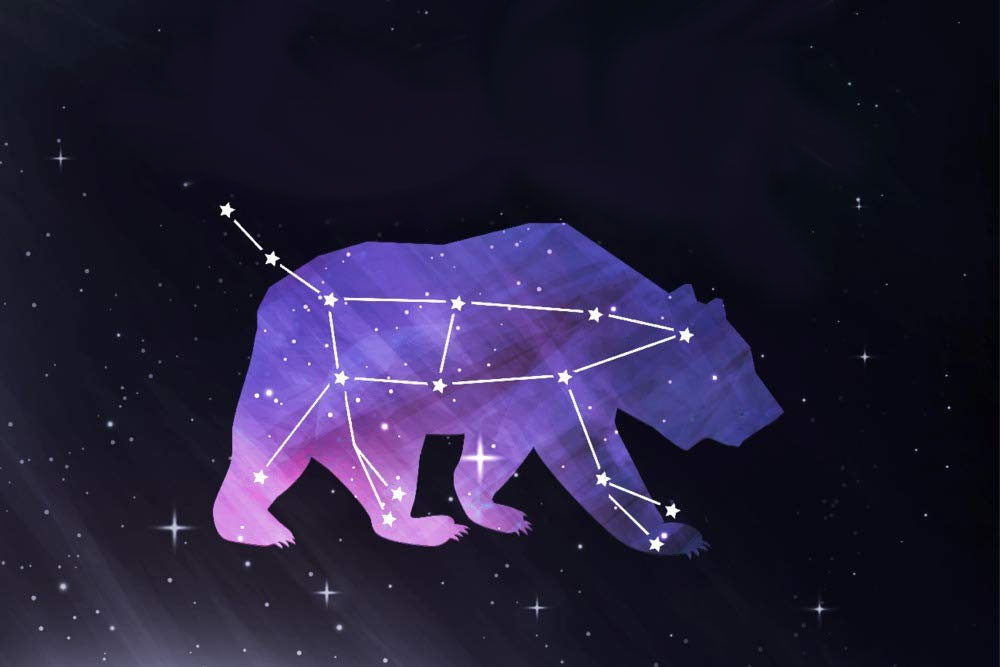
In classic Roman mythology, Ursa Major is associated with the myth of Callisto. Callisto was a young, attractive, human woman that caught the eye of Jupiter, the leader of the gods and the Roman equivalent to Zeus. Jupiter’s wife, Juno was jealous of Callisto so she decided to turn her into a bear and put her in the stars so Jupiter would no longer be attracted to her.
Callisto also had a son named Arcas, whom Juno suspected was Jupiter’s son. Arcas was later also transformed into a bear by Jupiter so he could be with his mother. This is the Ursa Minor (“The small bear”) constellation which is close to Ursa Major and also contains the “little dipper”.
Our current names for these two constellations come from those myths.
It is very curious that Ursa Major was associated with a bear in almost every ancient civilization, even when the origin of the myths was different. In the other side of the world, native Americans also called it “Great Bear” and they referred to the three stars behind it as hunters that were chasing it.
In China, they did not refer to the constellation as a bear, but they did refer to the Big Dipper as the North Dipper and gave proper names to all of the main seven stars.
In Japan, the seven main stars belong to Amenominakanushi, the most powerful kami (spirit). Some ancient Japanese swords have engraved the stars in them.
Using Ursa Major to navigate and find other stars
Some of the stars in the constellation can be really helpful if you ever find yourself lost in the middle of the night and you need to find your position and choose what direction you want to go to. Ancient travelers and sailors used them all the time to navigate and help them find their way in the middle of the sea where there are no landmarks to help you keep on the correct path.
But how and why can they be used for navigation? Well, to understand that first, we need to talk about Polaris. Polaris is a very bright star in a neighbor constellation called Ursa Minor. It is also known as the North Star because it doesn’t change much of its position in the sky and is located in the direction of the North Pole. That means that if you can find Polaris and point to it, that direction is the North. Pretty useful, right?
Now the problem is actually finding Polaris. While it is a very bright star, it is only the 49th brightest object in the night sky, so finding it isn’t always easy. Thankfully, there’s an easy way to locate it with the help of Ursa Major.
Because of the easily recognizable shape of the big dipper, it is generally easier to locate it than a single star. Once you find the dipper, all you need to do is trace an imaginary line using the two stars opposite to the “handle”. Those stars are Dubhe and Merak, or Alpha Ursae Majoris and Beta Ursae Majoris if you want to use their scientific names. If you extend that imaginary line, it points almost directly to Polaris.
The diagram below will help you visualize this method.
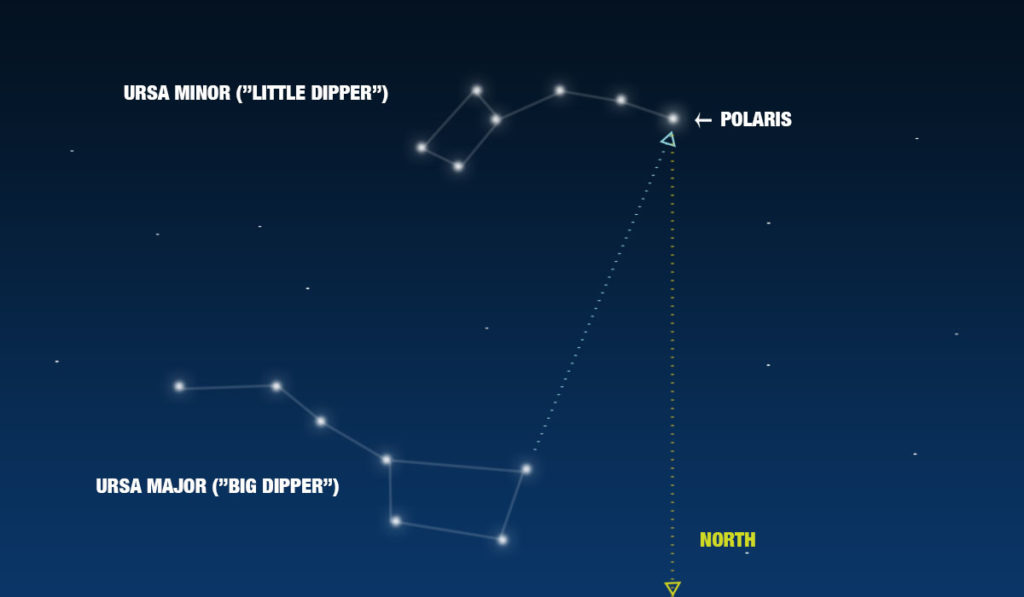
Stars in Ursa Major
There are 20 main stars that form the constellation with 7 of them forming the big dipper. Another 93 stars can be located in the area of the constellation and are named after it, but that number increases constantly as our telescopes get better and more stars are discovered.
The brightest star in the constellation is ε UMa (Epsilon Ursae Majoris), also named Alioth. It has a magnitude of 1.77, making it the 32nd brightest star in the sky.
The closest star to Earth in Ursa Major is Lalande 21185, a red dwarf star that is only 8.31 light-years away, making it the sixth closest star to Earth. Thanks to its close distance, it also makes it the brightest observable red dwarf in the Northern Hemisphere.
Here are a couple of tables detailing the known information for the main stars.
Big Dipper Stars
| Proper Name | Designation | Magnitude (brightness) | Distance (light-years) | Size (Compared to the Sun) |
| Alkaid | η UMa (Eta Ursae Majoris) | 1.85 | 81 | 3.4 |
| Alcor | 3.99 | 82 | 1.8 | |
| Alioth | ε UMa (Epsilon Ursae Majoris) | 1.76 | 81 | 4.14 |
| Megrez | δ UMa (Delta Ursae Majoris) | 3.32 | 81 | 1.4 |
| Phecda | γ UMa (Gamma Ursae Majoris) | 2.41 | 82 | 3 |
| Dubhe | α UMa (Alpha Ursae Majoris) | 1.81 | 124 | |
| Merak | β UMa (Beta Ursae Majoris) | 2.34 | 79 | 3 |
Other Main Stars
| Proper Name | Designation | Magnitude (brightness) | Distance (light-years) | Size (Compared to the Sun) |
| ψ UMa (Psi Ursae Majoris) | 3 | 147 | 19.7 | |
| Tania Australis | μ UMa (Mu Ursae Majoris) | 3.06 | 249 | 75 |
| Tania Borealis | λ UMa (Lambda Ursae Majoris) | 3.45 | 134 | 2.3 |
| Talitha | ι UMa (Iota Ursae Majoris) | 3.12 | 48 | |
| Muscida | ο UMa (Omicron Ursae Majoris) | 3.35 | 184 | 14 |
| Alula Borealis | ν UMa (Nu Ursae Majoris) | 3.49 | 421 | 57 |
| Alula Australis | ξ UMa A (Xi Ursae Majoris A) | 3.79 | 27.3 | 1.02 |
| χ UMa (Chi Ursae Majoris) | 3.69 | 196 | 20 | |
| Talitha Australis | κ UMa (Kappa Ursae Majoris) | 3.57 | 423 |
Fun Fact: What’s with the “Australis” and “Borealis” names? – When two stars have the same name – for example, Ursa Major has two stars named Tania and Talitha – a suffix can be added to distinguish them. The one to the South is named Australis, which is Latin for “south land” which is also where the name for Australia comes from. The one to the North is named borealis, also from Latin for “north side”.
Where to learn more
The following video from the American Museum of Natural History has some beautiful 3D renderings that will help you understand constellations and the position of the Ursa Major constellation in the Galaxy.
The Star Chart app (iOS | Android) is something we constantly recommend when you want to learn more about stars and constellations. It’s a great map of the sky on your phone.
Seeing Stars is a beautiful book by artist Sara Gillingham containing illustrations and some small bits of information about all the 88 constellations in the sky. It’s a great resource for any kid looking to learn more about the stars. You can check it out on Amazon.
Enjoyed this article?
Get daily 10-minute PDFs about astronomy to read before bed!
Sign up for our upcoming micro-learning service where you will learn something new about space and beyond every day while winding down.

